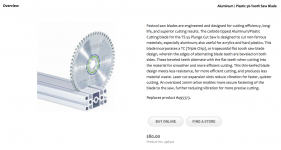- Joined
- Jun 25, 2016
- Messages
- 632
TSO is looking for an experience based recommendation for a on-ferrous (negative rake) saw blade for use in a TS-55 to cut plastic sheet HDPE.
Not sure if FESTOOL USA offers such a blade in North America at the moment.
Other brands and sources?
thanks for your help
Hans
Not sure if FESTOOL USA offers such a blade in North America at the moment.
Other brands and sources?
thanks for your help
Hans

